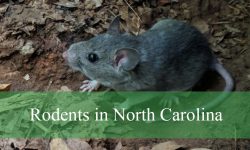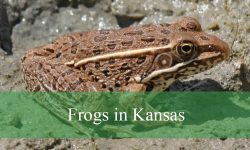Watching falcons soar over Pennsylvania’s rivers and fields is a truly mesmerizing experience. Their speed, precision, and sheer elegance make every sighting unforgettable. From tiny kestrels hovering above open meadows to Peregrine Falcons diving at astonishing speeds, each encounter feels like a front-row seat to nature’s aerial show.
During early mornings or crisp fall afternoons, I often find myself scanning the skies along open farmlands or river corridors, hoping to catch a glimpse of these skilled hunters. The way they perch on fence posts or telephone wires, surveying the landscape, always brings a moment of awe and anticipation. Their keen eyes and lightning-fast movements make observing them both challenging and exciting.
Exploring urban skylines where Peregrines nest on skyscrapers or venturing to Hawk Mountain Sanctuary during migration, Pennsylvania offers countless opportunities to witness falcons in action. Learning to identify each species adds a layer of connection and appreciation, transforming every outing into a memorable raptor adventure.
Common Falcons Found in Pennsylvania
American Kestrel (Falco sparverius)
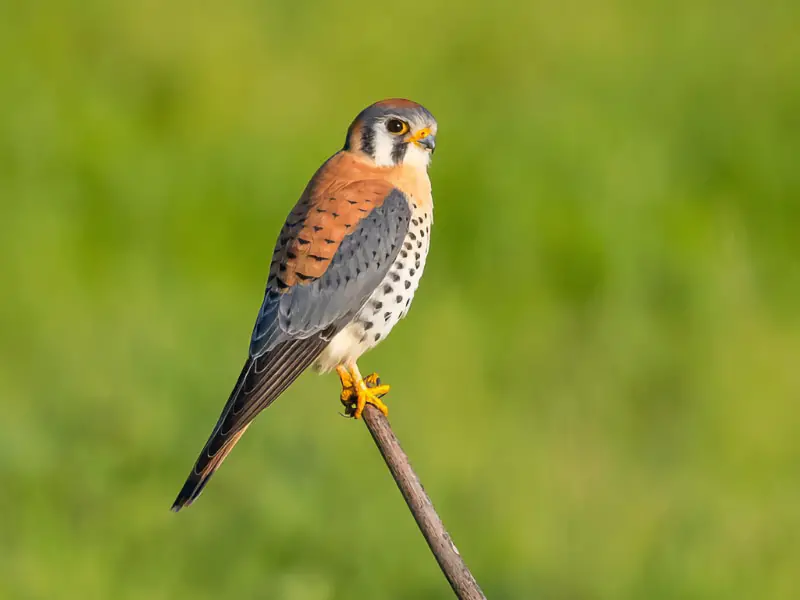
The American Kestrel is the smallest falcon in North America, measuring just 8 to 12 inches in length with a wingspan of 20 to 24 inches. Males are vividly colored with slate-blue wings and a rufous back, while females display more subdued brown tones with streaked patterns. Their faces are marked with two bold black vertical stripes, often called “mustache” and “sideburn” marks, making them easily identifiable even at a distance. In Pennsylvania, these striking little raptors are a common sight from spring through fall, often seen perched on telephone wires or hovering over open fields.
American Kestrels are highly adaptable hunters that feed primarily on insects, small rodents, and occasionally small birds. They are known for their remarkable hovering technique, often remaining suspended in the air while scanning for prey. This hunting strategy, combined with their sharp eyesight, allows them to detect the slightest movement in grass or along fence lines. During breeding season, they prefer cavities in trees, nest boxes, or even abandoned woodpecker holes, making them one of the most cavity-flexible raptors in the state.
Their habitats in Pennsylvania are diverse, ranging from farmland and meadows to suburban areas and open woodland edges. Kestrels thrive in areas with abundant perching opportunities and open hunting grounds, and they are often spotted near highways and fields where insects and small rodents are plentiful. Seasonal migration is common; northern populations tend to move south during the harsh Pennsylvania winters, while some southern residents may remain year-round if food sources are sufficient.
A fun fact about American Kestrels is their incredible diversity in hunting styles. They can hover in place like a helicopter, dart from a perch, or even chase prey mid-flight. Additionally, their calls are high-pitched “klee-klee-klee” sounds, often betraying their presence before they are seen. Despite their small size, they play a vital role in controlling insect and rodent populations across Pennsylvania landscapes.
Merlin (Falco columbarius)
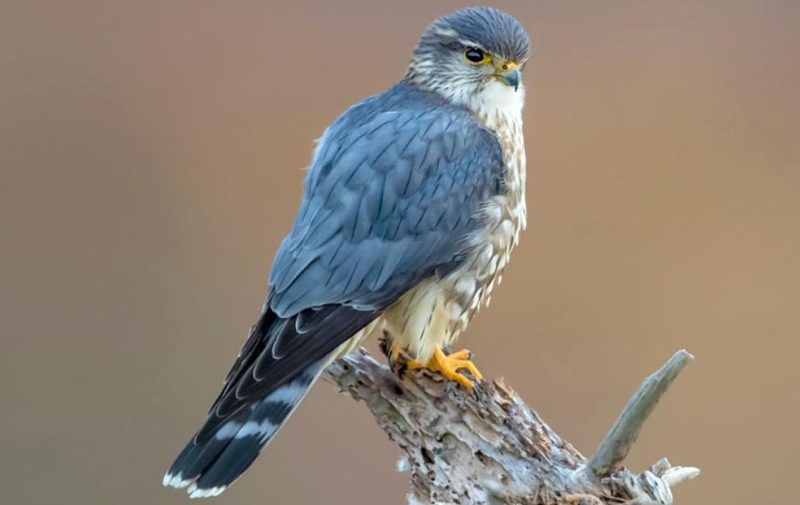
The Merlin is a small, fast falcon, typically measuring 9 to 13 inches in length with a wingspan of 20 to 27 inches. In Pennsylvania, male Merlins feature slate-gray plumage with faint streaking on the breast, while females are browner with heavy streaks. Their relatively short wings and stocky build distinguish them from other falcons in the region. Merlins are secretive and agile, often seen zipping through woodland edges or chasing songbirds in mid-air. Their fierce hunting style earns them the nickname “pigeon hawk,” although they primarily target smaller birds such as sparrows and starlings.
Merlins are known for their rapid, direct flight and aggressive aerial hunting techniques. They hunt by surprise attacks, often taking advantage of dense cover to launch lightning-fast pursuits. Their diet in Pennsylvania consists mostly of small birds, but they will also take insects and small mammals when available. During migration, Merlins are frequently observed in open fields, along forest edges, or in urban parks, where they can find abundant prey.
These falcons prefer habitats with a mix of open spaces and wooded areas. In Pennsylvania, they are often found in open forests, farmland, and along river corridors, where they can maneuver easily while hunting. Migration patterns are notable; northern breeders travel south to avoid the winter cold, while some resident Merlins in the state remain in areas with abundant prey. Breeding sites are typically in coniferous forests or open woodlands, with nests often located in abandoned hawk or crow nests.
A fun fact about Merlins is their extraordinary speed and determination in pursuit of prey. They are capable of chasing smaller birds over long distances and can reach bursts of speed during a dive, rivaling larger falcons. Despite their small size, Merlins have a bold temperament and are highly territorial during breeding season, often defending their nest sites with fierce aerial displays.
Peregrine Falcon (Falco peregrinus)
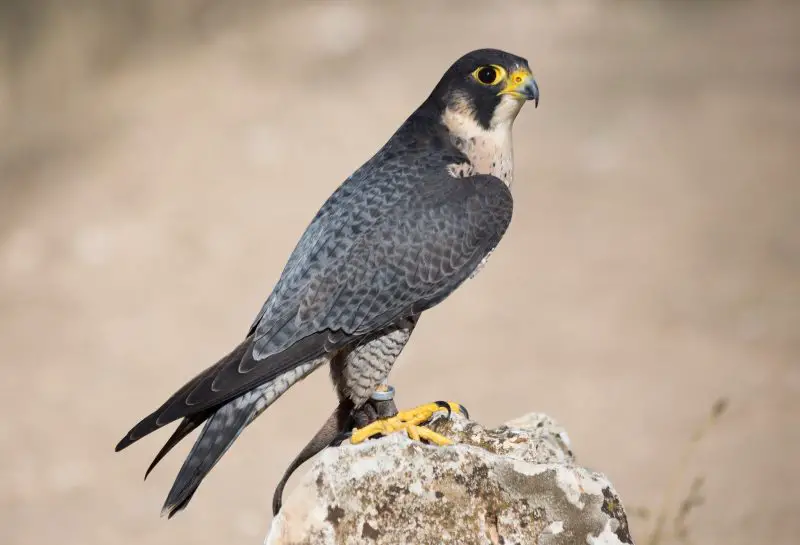
The Peregrine Falcon is one of the most iconic raptors in Pennsylvania, renowned for its extraordinary speed and hunting prowess. Adults measure 14 to 19 inches in length with a wingspan of 39 to 43 inches, making them powerful yet streamlined predators. Their plumage is slate-gray above, with a pale, barred underside and a distinct black “helmet” marking on the head. Peregrines are easily identified by their strong, pointed wings and swift, direct flight. They are found throughout Pennsylvania, particularly along rivers, cliffs, and increasingly in urban areas where tall buildings mimic their natural nesting cliffs.
Peregrine Falcons are specialized hunters, primarily preying on medium-sized birds such as pigeons, starlings, and waterfowl. Their hunting method, the famous “stoop,” involves a high-speed dive from a great height, striking prey mid-air with tremendous force. These raptors have excellent eyesight and can spot prey from hundreds of feet above the ground. In Pennsylvania, they are known to nest on cliff ledges along rivers and reservoirs, as well as on skyscrapers in cities like Philadelphia and Pittsburgh, where they have adapted impressively to urban life.
Habitat-wise, Peregrine Falcons require open hunting grounds adjacent to high perches. They thrive in areas with water bodies that attract migratory birds and are often seen in open countryside, coastal areas, and urban environments. Migration is less pronounced in Pennsylvania, with many birds remaining year-round, particularly those adapted to cities. Nesting success has improved significantly due to conservation efforts, including the installation of artificial nesting boxes on bridges and tall buildings.
A fun fact about Peregrines is that they are the fastest animals on the planet, capable of diving at speeds exceeding 200 miles per hour. They have been successfully reintroduced into Pennsylvania after historical declines due to DDT pesticide use. Peregrines often share nesting sites with urban pigeons, turning cities into unexpected sanctuaries for this high-speed hunter.
Gyrfalcon (Falco rusticolus)
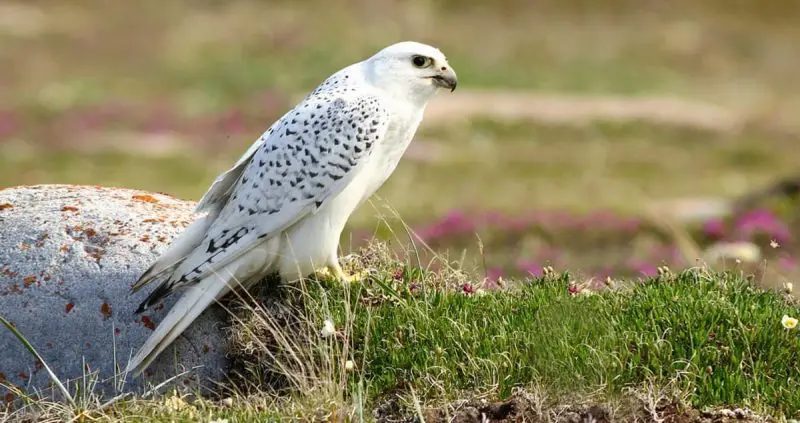
The Gyrfalcon is the largest falcon in North America, measuring 20 to 26 inches in length with a wingspan of 48 to 63 inches. Its plumage varies from nearly pure white to dark gray, often with heavy barring, providing camouflage in snowy Arctic habitats. In Pennsylvania, Gyrfalcons are extremely rare visitors, typically seen during harsh winter storms when northern populations drift southward. Their robust build, powerful wings, and large, hooked beaks make them formidable predators capable of taking large birds and mammals.
These falcons are specialized hunters, preying on ptarmigan, waterfowl, and sometimes leporids in their native Arctic regions. In Pennsylvania, their diet shifts opportunistically to whatever prey is available, including pigeons, ducks, and occasionally small mammals. Gyrfalcons are known for their endurance and ability to pursue prey across vast distances, demonstrating extraordinary aerial agility despite their size. They are solitary hunters and rarely tolerate intruders in their hunting territory.
Their usual habitats are tundra, cliffs, and open boreal forests, but during winter vagrancy, they are occasionally spotted in open fields, river valleys, and large lakeshores of Pennsylvania. Migration is irregular and often driven by food scarcity rather than seasonal cues. Sightings are uncommon, making any observation in the state highly exciting for birders and raptor enthusiasts.
A fun fact about Gyrfalcons is that they are prized in falconry for their strength, speed, and adaptability to cold climates. Despite their rarity in Pennsylvania, they occasionally provide thrilling winter highlights, with observers noting their powerful flight and ghostly appearance against snowy landscapes. Their scarcity and size make them one of the most impressive raptors that visit the state.
Prairie Falcon (Falco mexicanus)
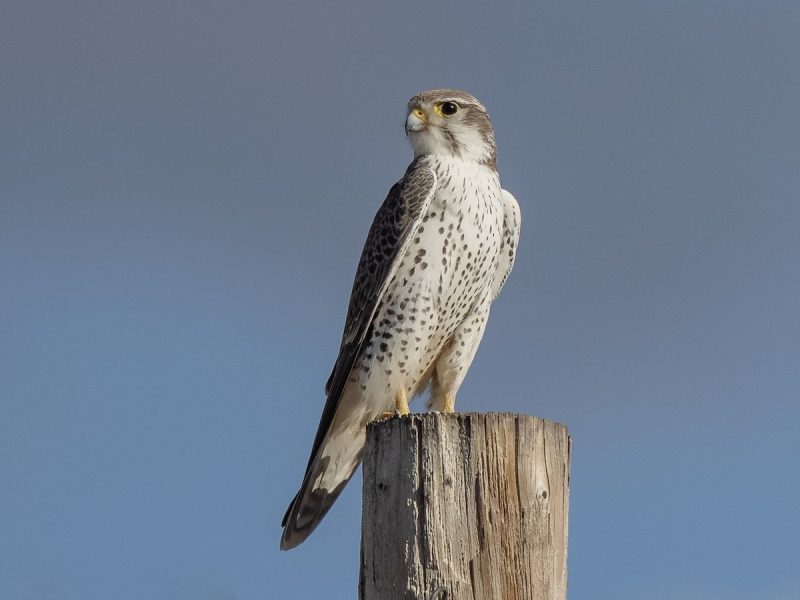
The Prairie Falcon is a medium-sized falcon, measuring 14 to 18 inches in length with a wingspan of 38 to 46 inches. Its plumage is pale sandy-brown with darker markings on the wings and a streaked breast. In Pennsylvania, Prairie Falcons are extremely rare vagrants, typically appearing far from their western Great Plains and Rocky Mountain strongholds. They are stocky yet streamlined, with long pointed wings and a distinctive dark malar stripe, helping to separate them visually from the Peregrine Falcon.
Prairie Falcons are agile hunters, primarily preying on small mammals such as ground squirrels and rabbits, though they will also take birds when available. They hunt by low-level flights over open terrain, employing fast, twisting maneuvers to capture prey. Their aggressive hunting behavior and ability to thrive in arid or open landscapes are key adaptations that have allowed them to dominate their usual western habitats. In Pennsylvania, any observation is a rare treat and often involves open farmland or river valleys.
These falcons favor open grasslands, deserts, and rocky cliffs in their native range but are occasionally found in eastern states during dispersal or migration. In Pennsylvania, they have no established breeding population, and sightings are usually solitary individuals blown east by unusual weather patterns. Habitat preference for open areas with few trees makes them easier to spot than woodland raptors when they appear.
A fun fact about Prairie Falcons is that they often hunt cooperatively when necessary, with pairs sometimes working together to flush out prey from burrows. Their rarity in Pennsylvania makes them highly sought after by birders, with each sighting carefully documented and celebrated. Despite being rarely seen in the state, their presence is a reminder of the remarkable reach of North America’s raptor species.
Best Time and Places to Spot Falcons in Pennsylvania
The best time to observe falcons in Pennsylvania varies by species and migratory patterns. For American Kestrels and Merlins, spring and fall migrations offer excellent opportunities, as these small falcons are frequently seen perched along roadsides, open fields, and woodland edges hunting for insects and small birds. Peregrine Falcons, on the other hand, can be spotted year-round, especially in urban areas like Philadelphia and Pittsburgh, where tall buildings mimic their natural cliff nesting sites, as well as along rivers, reservoirs, and large open water bodies that attract migratory birds.
Gyrfalcons are rare winter visitors, typically appearing during harsh northern winters or food-scarce seasons, and are most likely to be seen in open farmlands, river valleys, or along lakeshores when extreme weather pushes them southward. Prairie Falcons are very rare vagrants in Pennsylvania, so sightings are uncommon and usually limited to wide-open agricultural lands or sparsely wooded river corridors when unusual weather conditions drive them east from their western strongholds.
Early morning and late afternoon are often the best times to see falcons actively hunting, as they take advantage of optimal lighting and prey activity. Observers are more likely to spot falcons perched on telephone poles, fence posts, cliffs, or tall urban structures, scanning open fields or waterways for prey. High vantage points and open sightlines are key, as these raptors rely on excellent visibility to detect and swoop down on their prey with precision.
For enthusiasts seeking a guaranteed sighting, Pennsylvania state parks with river valleys, reservoirs, and open meadows, such as Presque Isle State Park, Hawk Mountain Sanctuary, and the Susquehanna River corridor, provide some of the most consistent locations to watch falcons in action. Additionally, joining local birding groups or participating in organized raptor counts during migration seasons can greatly increase the chances of observing these agile and fascinating birds up close.
FAQs About Falcons in Pennsylvania
What types of falcons can be found in Pennsylvania?
Pennsylvania is home to several falcon species, including the American Kestrel, Merlin, and Peregrine Falcon, which are regularly seen. Rare visitors include the Gyrfalcon and Prairie Falcon, which appear occasionally during harsh winters or unusual migration events. Each species has distinct behaviors, habitats, and hunting strategies that make them fascinating to observe.
When is the best time to see falcons in Pennsylvania?
The best time varies by species. American Kestrels and Merlins are most visible during spring and fall migrations, while Peregrine Falcons can be spotted year-round, especially in urban areas and along rivers. Gyrfalcons are rare winter visitors, and Prairie Falcons are very rare vagrants. Early mornings and late afternoons are ideal for observing active hunting behaviors.
Where are the best locations to observe falcons?
Open fields, river valleys, reservoirs, and urban areas with tall buildings provide excellent vantage points. Popular birding sites in Pennsylvania include Hawk Mountain Sanctuary, Presque Isle State Park, and the Susquehanna River corridor. Falcons often perch on telephone poles, fence posts, or cliff edges to scan for prey.
What do Pennsylvania falcons eat?
Diet varies by species. American Kestrels primarily eat insects and small rodents, Merlins target small birds, and Peregrine Falcons specialize in medium-sized birds like pigeons and waterfowl. Gyrfalcons opportunistically hunt birds and small mammals, while Prairie Falcons focus on small mammals and occasionally birds.
Are falcons endangered or protected in Pennsylvania?
Peregrine Falcons were once endangered due to pesticide use but have successfully recovered through conservation programs. All falcon species in Pennsylvania are protected under the Migratory Bird Treaty Act, making it illegal to harm, capture, or disturb them without proper permits.
How can I identify different falcon species?
Identification relies on size, coloration, flight patterns, and markings. American Kestrels are small with colorful plumage, Merlins are fast and streaked, Peregrines have a slate-gray “helmet,” Gyrfalcons are large and variable in color, and Prairie Falcons are pale brown with streaked breasts. Observing hunting style and habitat can also help differentiate species.
Can I attract falcons to my backyard?
While you cannot reliably attract wild falcons, providing nest boxes may support American Kestrels, especially in rural or semi-open areas. Maintaining open spaces and perches can also make your yard more visible to falcons hunting nearby, but direct feeding or interaction is discouraged to avoid dependency.



